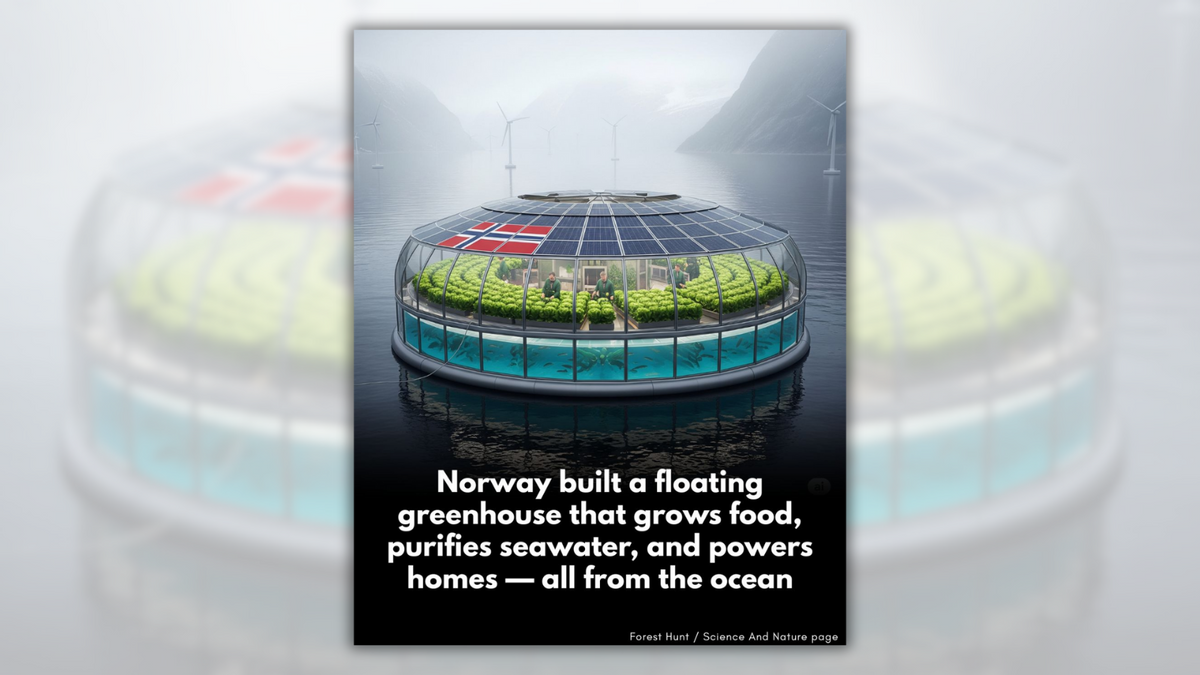Claim:
Images authentically show a floating greenhouse developed by Norwegian scientists called “Ocean Bloom.”
Rating:

Rating: Fake
Context:
While the purported “Ocean Bloom” greenhouse doesn’t exist and these images were AI-generated, there are real floating greenhouses — albeit much simpler in construction.
A series of social media posts in July 2025 allegedly showing images of a project apparently developed by Norwegian scientists called “Ocean Bloom” led Snopes readers to search for information about this supposed innovation.
A Facebook page called “Forest Hunts” posted (archived) about Ocean Bloom on July 7, the earliest date Snopes could find a reference to it. According to the post, which included an image of the purported invention, Ocean Bloom was a floating greenhouse developed by Norwegian scientists that could grow food, desalinate seawater to be used as irrigation, generate enough surplus energy to power nearby villages and act as a carbon sink. Forest Hunts’ post got more than 80,000 reactions.
https://www.facebook.com/permalink.php?story_fbid=pfbid02147Vxc44tVe94hX8jcwhLkgrC18ktbz5tBzc97Ej6UEpctTvQGzutSZnLxixuz9sl&id=61569370738767
Another Facebook page posted (archived) about Ocean Bloom, with a different image of a floating greenhouse, on July 19, this one generating more than 20,000 reactions. The image posted by that page was later shared to X (archived), where it was viewed more than 65,000 times.
However, there was no evidence this “Ocean Bloom” greenhouse exists, and both images of the greenhouse were AI-generated. For this reason, we’re rating this claim as fake.
Google searches for “norwegian ocean bloom,” “ocean bloom greenhouse” and “floating greenhouse” returned no relevant news stories, research articles or news releases regarding Ocean Bloom.
Additionally, both images meant to show this floating greenhouse contained errors common in AI-generated images. The faces of the people in the Forest Hunts image appeared to be disfigured, and one of the hands of the centermost person was unnaturally long, looking more like a tentacle than a hand. In the other image, part of the centermost wind turbine melted into the top of the greenhouse, even though the turbine should have been in front of it.
Sightengine, a tool for detecting AI-generated images, rated both images as “likely AI-generated.”
The Forest Hunts Facebook page appeared to specialize in posting about often-fabricated scientific discoveries, advancements and innovations paired with AI-generated images. The posts followed a consistent formula in which the discoveries were credited to scientists from a specific country and were in some way sustainable.
In one 24-hour period from July 22 to July 23, the page posted 20 times, all about different scientific discoveries. In one post during that time, Forest Hunts wrote about the invention of a robotic jellyfish that eats microplastics created by South Korean scientists, but similarly to Ocean Bloom, a Google search found no evidence of such a creation. One post, about a researcher from Mexico working to turn a cactus into a biodegradable plastic, was based on real research, albeit alongside an AI-generated image. However, there was no evidence to support another post apparently about a near-identical project by Chilean scientists to create a biodegradable plastic out of a different species of cactus.
In the case of Ocean Bloom, it appeared the story took inspiration from a real-life floating greenhouse, the Jellyfish Barge. The Jellyfish Barge was created in 2014 and runs on solar power to grow food and desalinate seawater for its own use. PNAT, the team of Italy-based researchers responsible for the Jellyfish Barge, did not claim that it was capable of generating enough surplus energy to power nearby villages, although it did mention that future upgrades to the greenhouse’s power system could allow “integration with grid electricity if needed.”
The Jellyfish Barge looks wildly different than AI-generated floating greenhouses. Its construction is largely of wood instead of glass and metal.
Sources:
“AI Image Detector. Detect AI-Generated Media at Scale.” Sightengine, sightengine.com/detect-ai-generated-images. Accessed 23 July 2025.
Humburg, Adam. “This Researcher Is Making Biodegradable Plastic from Cactus Leaves.” Final., 11 June 2019, finalstraw.com/blogs/the-finalword/this-researcher-is-making-biodegradable-plastic-from-cactus-leaves. Accessed 24 July 2025.
“Jellyfish Barge: Urban Greenhouse | PNAT.” PNAT, www.pnat.net/project/6564/. Accessed 24 July 2025.
“Norwegian Ocean Bloom – Google Search.” Google.com, 202AD, www.google.com/search?q=norwegian+ocean+bloom&sca_esv=a324f93b4d046afe&source=lnt&tbs=cdr%3A1%2Ccd_min%3A%2Ccd_max%3A7%2F23%2F2025&tbm=. Accessed 23 July 2025.
